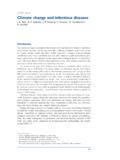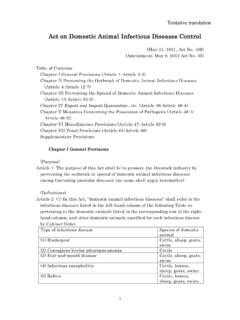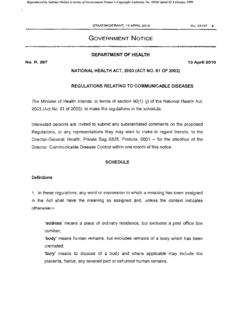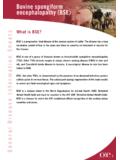Transcription of Chapter 2 Disease and disease transmission
1 7 Disease AND Disease TRANSMISSIONC hapter 2 Disease and Disease transmissionAn enormous variety of organisms exist, including some which can survive andeven develop in the body of people or animals. If the organism can causeinfection, it is an infectious agent. In this manual infectious agents which causeinfection and illness are called pathogens. Diseases caused by pathogens, or thetoxins they produce, are communicable or infectious diseases (45). In this manualthese will be called Disease and Chapter presents the transmission cycle of Disease with its different elements,and categorises the different infections related to Introduction to the transmission cycle of diseaseTo be able to persist or live on, pathogens must be able to leave an infected host,survive transmission in the environment, enter a susceptible person or animal, anddevelop and/or multiply in the newly infected transmission of pathogens from current to future host follows a repeatingcycle.
2 This cycle can be simple, with a direct transmission from current to futurehost, or complex, where transmission occurs through (multiple) intermediatehosts or cycle is called the transmission cycle of Disease , or transmission cycle. Thetransmission cycle has different elements: The pathogen: the organism causing the infection The host: the infected person or animal carrying the pathogen The exit: the method the pathogen uses to leave the body of the host transmission : how the pathogen is transferred from host to susceptible personor animal, which can include developmental stages in the environment, inintermediate hosts, or in vectors8 CONTROLLING AND PREVENTING Disease The environment: the environment in which transmission of the pathogentakes place. The entry: the method the pathogen uses to enter the body of the susceptibleperson or animal The susceptible person or animal: the potential future host who is receptive tothe pathogenTo understand why infections occur in a particular situation, and to know how toprevent them, the transmission cycles of these infections must be understood.
3 Therest of this Chapter looks at the elements of the transmission cycle in more The different elements of the transmission cycle of diseaseThe environmentTransmissionThe hostThe pathogenThe pathogen leavesthe hostEntry of the pathogenThe susceptible personor animal9 Disease AND Disease The pathogenThe pathogen is the organism that causes the infection.* Specific pathogens causespecific infections. Cholera is caused by the bacterium Vibrio cholerae, forexample, and Leishmaniasis is caused by different species (spp.) of the infections also have specific transmission cycles. To be able to reactappropriately to health problems in a population, the specific infection causing theproblems must be known. Identification of the infection will usually be done bymedical categories of pathogens can infect humans. The pathogens causing thediseases covered in this manual include viruses, bacteria, rickettsiae, fungi, proto-zoa, and helminths (worms).
4 All pathogens go through a lifecycle, which takes theorganism from reproducing adult to reproducing adult. This cycle includes phasesof growth, consolidation, change of structure, multiplication/reproduction, spread,and infection of a new host. The combination of these phases is called thedevelopment of the terms are commonly used to describe pathogens leaving the host throughfaeces or urine: latency and excretion, a latent pathogen must develop in the environment or intermedi-ate host before a susceptible person or animal can be infected. During the latentperiod the pathogen is not infectious. A non-latent pathogen does not need to gothrough a development, and can cause infection directly after being describes how long a pathogen can survive in the environment. Apersistent pathogen remains viable for a long period outside the host (perhapsmonths), while a non-persistent pathogen remains viable for only a limited period(6) (days, or weeks).
5 Active immunity is the resistance the person or animal develops against thepathogen after overcoming infection or through immunisation (vaccination).(45).Depending on the pathogen, the effectiveness of active immunity often decreasesover time.*It is important to realise that not all infections will result in Disease . While a pathogen may cause illness in oneperson, it may be killed or cause asymptomatic infection in AND PREVENTING DISEASEU sually immunity only develops against the specific pathogen that caused theinfection. If there are different types (serotypes or strains) of the same pathogen( in dengue fever and scrub typhus), immunity will often only develop againstthe particular type which caused the infection. The person or animal can stilldevelop the illness when infected with another serotype or strain of the patho-gen(3).Table presents the different categories of pathogenic organisms with some oftheir characteristics, including latency, persistence, and immunity.
6 The informa-tion is general, and exceptions can The hostThe host is the person or animal infected by the pathogen. The importance of thehost in the transmission cycle is its roles as both reservoir and source of are two types of host: definitive and intermediate host. The definitive host isthe person or animal infected with the adult, or sexual, form of the pathogen. Inthe infections covered here, people are usually the definitive host. To keep thingssimple the definitive host is called just the host .The intermediate host is an animal or person infected by a larval, or asexual, formof the pathogen(3). Cysticercosis and hydatid Disease are the only infectionscovered here for which people are the intermediate host. Where intermediate hostis meant, this term is used. Of the infections covered here, only helminths haveboth definitive and intermediate hosts. All other pathogens only have definitivehosts, although vectors function technically as intermediate hosts for : transmission from animal to personSome pathogens are specific to humans, others to animals.
7 Many pathogens areless specific and can infect both people and animals. Infections that can naturallybe transmitted from animal to person are called zoonoses (3). Zoonoses are verycommon; over half of the infections covered in this manual are zoonoses. Many ofthese infections normally occur in an animal cycle, with people being infected problem with zoonoses is that a continuous reservoir of pathogens existsoutside humans. Even if all human infections were cured and transmission topeople stopped, the presence of an animal reservoir would remain a continuousrisk to AND Disease TRANSMISSIONT able Categories of pathogenic organisms and their characteristicsPathogenVirusRickettsiaeB acteriaFungiProtozoaHelminths(worms)Desc riptionParticles invade livingcells. The pathogenneeds structures inthese cells toreproduce. (45)Organisms resemblebacteria. (45).However, similar toviruses, the pathogenneeds to developinside the cells of thehost.
8 (2)Bacteria are single cellorganisms. They areconsidered moreprimitive than animalor plant cells. (45)A group of organismswhich include yeast,moulds, andmushrooms. (45)Protozoa area singlecell organisms. (45)Helminths are worms(roundworms, flukes ortapeworms) (45). Oftenmale and female mustmeet in host toreproduce, andsometimes theymultiply inintermediate pathogensare pathogensare pathogensare pathogen islatent. It oftenhas a complexlifecycle with adevelopment inthe environmentor intermediatehosts. (73)PersistenceViruses cansurvive formonths intropicaltemperatures.(28)n/aPersists up toseveral weeks.(16,73). Canmultiply outsidethe host. (3)n/aForms aresistant cystwhich cansurvive formonths. (3,44)The pathogen ispersistent andsome maysurvive for yearsin theenvironment.(3, 16)AdditionalinformationWhere vector-borne, transmission tooffspring ispossible(3) .The immunity isoften long-lasting.
9 (73) transmission ofthe pathogen tothe offspring ofthe vectoroccurs.(73) . Theimmunity isusually long-lasting. (3)The immunitydeveloped isoftenincomplete orshort-lived. (3)The duration ofthe immunity isvariable. (3)The immunity isonly maintainedby repeatedinfections orvaccinations. (73)Usually noimmunity is builtup against thepathogen. (3)n/a: Not applicable as the pathogens are not AND PREVENTING DISEASEP revention of zoonoses often includes control of animal hosts. This is possible byreducing the number of hosts ( controlling rats), immunising domestic ani-mals, or avoiding unnecessary contact with host : hosts without obvious illnessA person or animal who develops an illness is an obvious example of a host. It isvery common, however,for infections to occur without the Disease person or animal infected can potentially spread the pathogen, but does notshow clear symptoms (8).
10 The symptoms may be mild, or may be hosts are called carriers, or asymptomatic carriers. Table shows someinfections that are frequently mild or asymptomatic. The host can be infectious fora short period in transient carriers, or over a prolonged period in a chroniccarrier(3). Incubating carriers have been infected and can spread the pathogen, butdo not yet show the symptoms of the illness. Convalescent carriers continue tospread the pathogen even though they have recovered from many infections carriers play an important role in transmitting the pathogen. Itis usually not possible to identify asymptomatic carriers (73), and unless the familyand other close contacts of the sick person or even the whole population can betreated, carriers will remain a threat to the health of those surrounding Examples of infections with asymptomatic carriersInfectionBacillary dysenteryCholera (El Tor)GiardiasisPolioTyphoid feverSchistosomiasisHookwormYellow feverJapanese EncephalitisFilariasisMalariaRiver blindnessPlagueAsymptomatic infectionscommon (3)only 1 in 30-50 infections develops illness (16)1 in 2-4 infections develops illness (44)very commonvery common (73)very common (16)very commoncommon (3)only 1 in 1,000 infections develops illness (44)very commoncommon (3)common (2)common during epidemics (73)

















